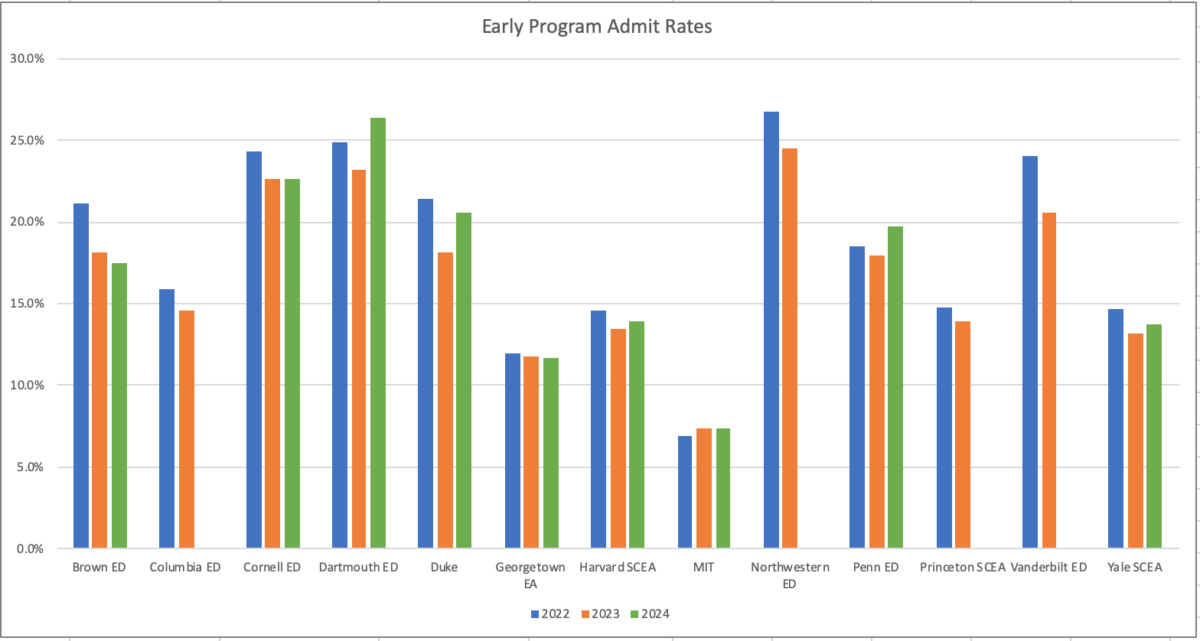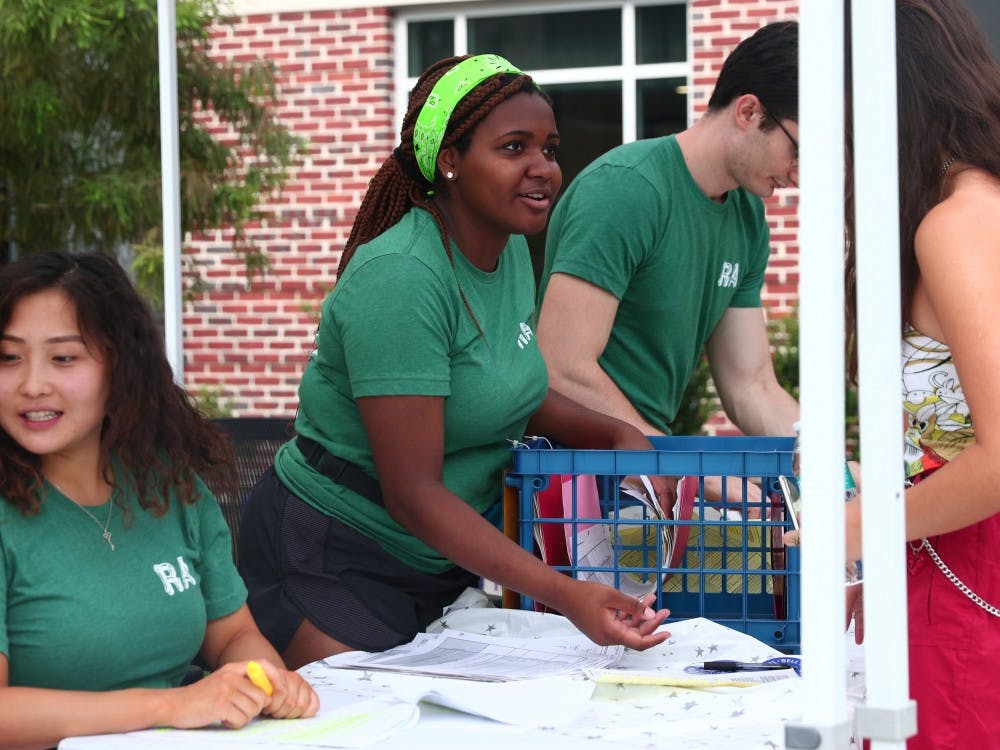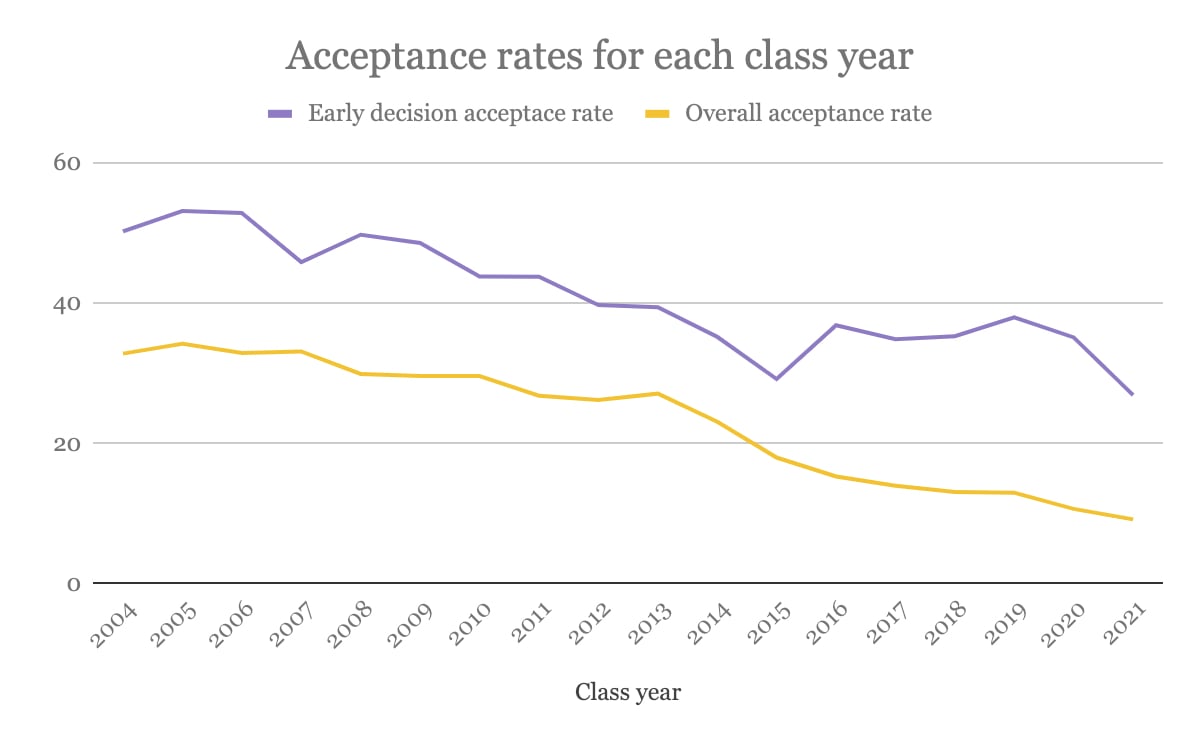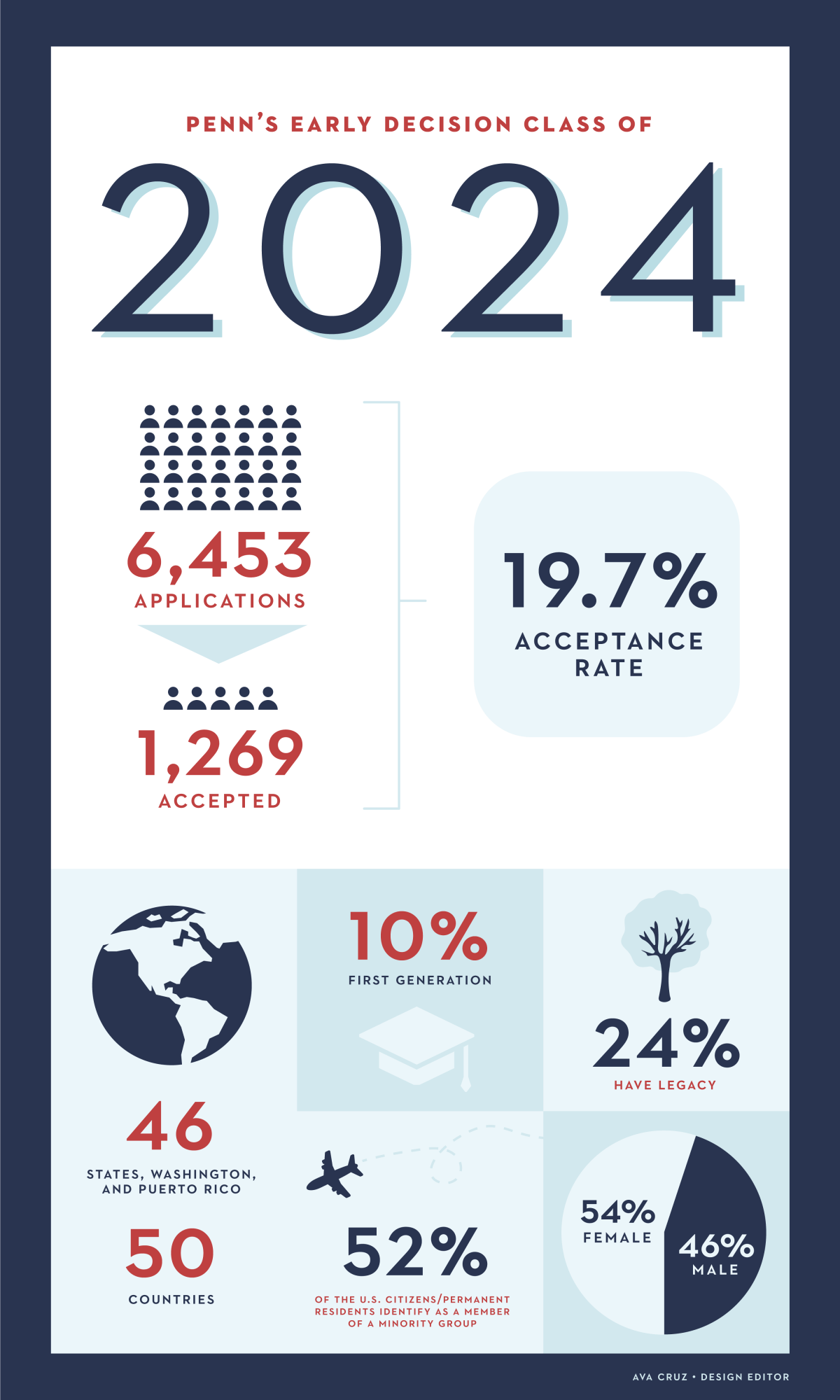Suppose a college needs to enroll 2,000 students in its incoming class. Suppose it receives roughly 12,000 applications each year in the regular admissions cycle—a realistic estimate for a prestigious, selective school. Suppose, finally, that its normal yield for students admitted in the regular cycle is 33 percent—that is, for each three it accepts, one will enroll. So to end up with 2,000 freshmen on registration day, a college relying purely on a regular admissions program would send "We are pleased to announce" letters to 6,000 applicants and hope that the usual 33 percent decided to enroll. A regular-only admissions policy would thus mean that the college's selectivity rate—6,000 acceptances for 12,000 applicants—was an unselective-sounding 50 percent. Keep in mind the school's standards and the overall strength of your application are important factors in whether you get accepted, regardless if you choose early decision or apply later in the application cycle.
However, if you apply early you may have a better chance of getting into your college of choice. Typically, early admission rates are higher than regular or overall admission rates for most schools. At some schools, the admission rate can be substantially better for early admission candidates. In fact, of the students who applied early to the University of Pennsylvania, nearly 25 percent were accepted, compared to only 9 percent who were admitted through the regular application process. The most intriguing twist on the SAT emphasis is applied at Georgetown, one of a handful of schools still offering nonbinding early action.
Whereas Harvard knows that nearly all the students admitted EA will enroll, Georgetown knows that most of the academically strongest candidates it admits early will end up at Yale or Stanford if they get in. Georgetown sticks with EA in part because Charles Deacon, its dean of admissions, is a prominent critic of the increased use of binding programs and the sense of panic and scarcity they create among students. Because colleges often highlight the average SAT scores of the students they admit, not just the ones who enroll, a policy like Georgetown's can make a school look better. Admission StandardsEliteApplicant CompetitionExtremeHow hard is it to get into Penn and can I get accepted? The school has a 8% acceptance rate ranking it #1 in Pennsylvania for lowest rate of acceptance.
Last year, 3,740 out of 44,491 applicants were admitted making Penn an extremely competitive school to get into with a very low chance of acceptance – even for applicants with the highest scores and grades. Academically, it has exceptionally high requirements for admission test scores, generally admitting students who score in the top 4 percent. University of Pennsylvania typically accepts and attracts "A-" average high school students. With over half of admitted students enrolling, acceptance by University of Pennsylvania is a prized outcome for many students. Most incoming freshmen graduated in the top ten percent of their high school class.
Colleges had already been posting extremely competitive acceptance rates, with eight percent, or fewer, applicants gaining acceptance to the top tier schools, according to statistics from U.S. To increase their chances of acceptance, students frequently choose one university and apply early decision or restrictive early action. Despite having the lowest acceptance rate in their school's history, so far, Penn has the highest acceptance rate among the Ivy League schools that released their data. On Tuesday, Dec. 12, Harvard University admitted just 964 students out of 6,630 applicants, an admission rate of just 14.5 percent to their early admissions program.
Earlier on Wednesday, Princeton University sent out early action admission offers to 799 lucky school seniors to the Class of 2022, out of a record 5,402 applications. Princeton's acceptance rate was a record low with only 14.7 percent of student accepted. Students who apply early decision enjoy a higher admissions rate than those who apply through regular decision. For example, Ivy League institutions typically admit between 5 and 11 percent of students who apply during regular decision but admit 14 to 23 percent of those who apply early decision. Other institutions such as American University, Trinity University, and Providence College have early acceptance rates that are 50 to 70 percentage points higher than the regular acceptance rate.
Researchers estimate that applying early decision provides the equivalent benefit of an extra 100 points on the SAT, the standardized test widely used for college admissions. This would effectively mean that the early boost, and Tulane's actual selectivity, is not what it seems. The advantage of applying Early Decision is that acceptance rates for ED applications are sometimes two to three times higher than the Regular Decision admission rates at the same schools. For instance, Northwestern's overall acceptance rate is only 9%, but its early decision rate is closer to 25%. And the early decision rates at schools like Washington University in St. Louis, Emory University, and Tufts University are all multiple times the regular decision admission rate.
In last year's regular admissions cycle, Princeton admitted a record-low 1,498 students out of 37,601 applicants for an acceptance rate of 3.98 percent — a steep drop from the 5.6 percent acceptance rate for the Class of 2024. An additional 149 students had deferred admission or were admitted off the waitlist for a total acceptance rate of 4.38 percent. The sheer increase in the number of applications received is the only reason for Penn's significantly smaller acceptance rate.
More high school seniors are applying for early admission programs giving schools more quality applicants to choose from for their incoming class. This year Penn saw an increase of 9.5 percent from last year in the number of early decision applications they received, that number is 38 percent more from when the Class of 2018 applied in 2013. For the Class of 2021, Penn received what was then a record 6,147 applications.
Of the 56,333 students who applied to Penn's Class of 2025 in the early and regular rounds, 3,202 were admitted, leading to an overall acceptance rate of 5.68 percent. The 3,202 admitted students to the Class of 2025 included 1,194 students who were admitted through the early decision round. The admission rate for the ED round was 15 percent out of 7,962 applicants.
Last year, 42,205 students applied to Penn's Class of 2024 in the early and regular rounds and 3,404 were admitted, leading to an overall acceptance rate of 8.07 percent. Out of the total 3,404 admitted to the Class of 2024, 1,269 students were admitted through the early decision round. The admission rate for the ED round was 19.67 percent out of 6,453 applicants. For the Class of 2023, 44,960 students applied to in the early and regular rounds and 3,345 were admitted, leading to an overall acceptance rate of 7.44 percent.
The massive increase of applicants, and resultant decline in acceptance rates, were a surprise to many in the college industry. After all, many students were unable to take SAT exams, participate in sports or other extracurricular activities, or even attend classes in person. But they may have gotten a false sense of security from the fact that more than 1,500 colleges and universities – including all eight Ivies – did not require SAT or ACT scores from applicants. Of course, students with stellar test scores did submit their scores for consideration.
In addition, virtual outreach events allowed colleges to reach more students than they had in the past when they relied mainly on in-person college visits to entice future applicants. Moreover, when a college or university fills a substantial portion of its class with early decision acceptances, fewer spots remain for regular decision applicants. Colleges and universities such as Davidson, Emory, Swarthmore, and Tufts fill close to half of their freshman spots through early decision. The University of Pennsylvania enrolled 53 percent of its class of 2023 from its early decision applicant pool.
Early decision admissions policies allow high school students to apply earlier to a university, typically by November of their senior year, with the students committing to attend that university if accepted. The binding nature of early decision means that only students who can commit to a university before seeing their financial aid offer can take advantage of the policy. Most students cannot apply under such terms, especially as the cost of college is increasing almost eight times faster than wages. It means having strong grades and SAT scores by the end of junior year and not thinking that one's record needs to be rounded off or enriched by senior-year performance. It means that one's family has enough money to be unaffected by the possibility of competitive financial offers.
It means that one is emotionally prepared to deal with a rejection if necessary and then to rush regular applications into the mail right away. In ED programs students start their senior year ready to choose the one college they would most like to attend, and having already taken their SATs. An early applicant is allowed to make only one ED application, and it is due in the beginning or the middle of November. The college has about a month to deliberate and responds by mid-December. If the answer is no, the student has two weeks to send out regular applications to schools on his or her backup list. If the answer is yes, the process is over, because by virtue of applying early, the student has promised to attend the college if accepted.
Mainly through counselors, who know when a student has been admitted ED and agree not to send official transcripts to other schools. I cannot stress enough how much it helps to apply early if you're sure you want to attend Penn. For reference, this year, the early decision acceptance rate at the university was 22%, whereas only 7.3% of applicants were accepted in the regular decision round. Some colleges — such as Stanford, Harvard, Princeton, and Yale — practice Restrictive Early Action (also known as Single-Choice Early Action).
In Restrictive Early Action , applicants are allowed to apply to only one private college under Early Action. In early November, thousands of hardworking students across the country will send in their early decision or early action applications for coveted spots at the nation's most prestigious colleges. Unfortunately, the reality is that both policies, especially early decision, reinforce the racial inequities in the U.S. education system. Cornell does not announce decisions until Dec. 17 but has previously said it would not announce acceptance rates while admissions are ongoing. Cornell does, however, report detailed undergraduate admissions data including the number of students who applied, were admitted, and matriculated through each admissions cycle. Now suppose that the college introduces an early-decision plan and admits 500 applicants, a quarter of the class, that way.
University Of Pennsylvania Admissions Early Decision It is very likely to receive at least as many total applications as before—say, 1,000 in the ED program and 11,000 regulars. But now it will have to send out only 5,000 acceptance letters—500 earlies plus 4,500 to bring in 1,500 regular students. Therefore its selectivity will improve to 42 percent from the previous 50, and its yield will be 40 percent rather than the original 33, because all those admitted early will be obliged to enroll. The real question about the ED skew is whether the prospects for any given student differ depending on when he or she applies. Last fall Christopher Avery, of Harvard's Kennedy School of Government, and several colleagues produced smoking-gun evidence that they do.
The authors analyzed five years' worth of admissions records from fourteen selective colleges, involving a total of 500,000 applications, and interviewed 400 college students, sixty high school seniors, and thirty-five counselors. They found that at the ED schools an early application was worth as much in the competition for admission as scoring 100 extra points on the SAT. For instance, a student with a combined SAT score of 1400 to who applied early was as likely to be accepted as a regular-admission student scoring 1500 to 1600. An early student scoring 1200 to 1290 was more likely to be accepted than a regular student scoring 1300 to 1390. The colleges take three months to consider the applications, and respond by early April.
Students have until May 1—the single deadline in this cycle adhered to by most colleges—to send a deposit to the school they want to attend and a "No, thanks" to any other that has accepted them. The colleges tally the returns and adjust the size of their incoming classes by accepting students on their waiting lists. Williams College accepted 255 students (31.3% acceptance) to the Class of 2026 through this year's early decision admissions process.
There were 814 total early applicants, of whom around 180 were deferred to the spring's regular decision pool, with the remaining 400 or so denied admission. A whopping 56,333 applications were received by Penn for the Class of 2025, the largest applicant pool to date; only 3,202 individuals were accepted. Working out to 5.68% acceptance rate, this was the most selective year in the university's lengthy history. Applicants for the Classes of 2016 and 2017 saw admit rates in excess of 12%; the Class of 2018 is when the school's admit rate first dipped below 10%. The two years prior to the Class of 2025 cycle, 8.07% and 7.4% were accepted.
A rolling admissions process is an entirely different kind of early admissions process. Because applications are reviewed and decided as they are received, applying early will always boost your chances. In rolling admissions, a college opens itself to receiving applications over a large time frame and promptly notify applicants of their decisions within weeks of your application's submission.
Because your chances of securing a spot in rolling admissions are higher when the spots are plentiful, the sooner you apply the better. Indiana University—Bloomington and Penn State University are two popular colleges that have rolling admissions. Another 1% of the early class may be reserved for musical recruits (i.e. orchestra and band) and 1.8% of early applicants may have withdrawn or failed to complete the submission of required documents. These additional students drop the early acceptance rate for non-recruited students even lower to a final resting spot of about 14.3%.
The University accepted 896 students to the class of 2026 from a pool of 6,146 early decision applicants, according to Dean of Admission Logan Powell. The early acceptance rate, number of applicants and number of accepted students were all records in the history of the University's early decision program. Applying early to colleges isn't absolutely necessary, but it's certainly advantageous. Colleges like to see early applicants, and the statistics show it.
Both early decision and early action applicants are accepted at a higher rate than their standard deadline counterparts. Of course, applying early also has several other benefits for applicants. Early action and early decision applicants are notified of their acceptance status much sooner than standard deadline applicants.
Armed with that knowledge sooner rather than later, each applicant can take extra time to pursue other options or get familiar with their new dream school. University of Pennsylvania admissions are extremely selective with a low acceptance rate. Applicants even with above-average scores have very little chance of getting admitted. Essay and LOR should be emphasized while making the application as a good essay and strong recommendation can set you apart in this tough competition. The admission decision are announced by Mid December for Early Decision applicants and by April 1 for Regular Decision applicants. Mid-December is early admission decision time and almost every other day anxious high school seniors await an email from the school of their dreams that will determine their future.
Ivy League school the University of Pennsylvania sent out 1,312 early decision offers of admission for the Class of 2022. This year Penn received a record number of applications, 7,074 students applied, and 15 percent more to the early decision program for the Class of 2021. As result, the college has its record lowest early admission rate in history at just 18.5 percent down from last year's 23.2 percent. Your child can apply to Penn via a binding early decision agreement by November 1st. They'll receive an answer of accepted, deferred to the regular decision pool, or denied by mid-December. Penn admits roughly half of their incoming class through early decision, but the UPenn early decision acceptance rate is still low, around 15 percent.
Penn's yield rate—the percentage of accepted students who elect to enroll, divided by the total number of students who are admitted was 70% in 2019. The takeaway is that an exceptionally high number of those admitted to Penn ultimately choose to attend the university. Part of the explanation for this is that the majority of the class was brought aboard via binding early decision. For comparison, elite schools such as Duke, Northwestern, Notre Dame, and Claremont McKenna all have yield rates under 60%. Given its renowned reputation as one of the best medical schools in both the U.S. and the world, Penn Med's admissions process is extremely rigorous.
It's also highly selective, with one of the lowest acceptance rates in the country. You can withdraw or change the status of your early application at any time before an admissions decision is reached. Swarthmore College also waived its requirement and 47% of applicants didn't submit scores. The college admitted 1,014 students, or 7.8% of applicants, making this year its most selective.
Its admitted students come from six continents, 86 nations, and the 50 states, and 30% are first-generation students, the college said. Some university leaders understand the discriminatory effect of early decision policies and the benefits of expanding access to educational opportunity. Harvard University ended its early decision program in 2006 and now uses a restrictive early action policy that is nonbinding. After the University of Virginia ended its early decision policy in 2007, the dean of admissions reported increased class diversity and academic accomplishment.




























No comments:
Post a Comment
Note: Only a member of this blog may post a comment.